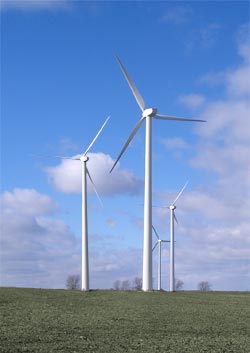wind energy conversion system

A wind energy conversion system is an apparatus for converting the kinetic energy available in the wind to mechanical energy that can be used to power machinery (grain mills, water pumps, etc) and/or to operate an electrical generator. See also wind energy. Thanks to extensive R&D efforts during the past 30 years, wind energy conversion has become a reliable and competitive means for electric power generation. The life span of modern wind turbines is now 20-25 years, which is comparable to many other conventional power generation technologies. The average availability of commercial wind power plants is now around 98%. The cost of wind power has continued to decline through technological development, increased production level, and the use of larger turbines.
The major components of a typical wind energy conversion system include a wind turbine, a generator, interconnection apparatus, and control systems. At the present time and for the near future, generators for wind turbines will be synchronous generators, permanent magnet synchronous generators, and induction generators, including the squirrel-cage type and wound rotor type. For small to medium power wind turbines, permanent magnet generators and squirrel-cage induction generators are often used because of their reliability and cost advantages. Induction generators, permanent magnet synchronous generators, and wound field synchronous generators are currently used in various high power wind turbines.
Interconnection apparatuses are devices to achieve power control, soft start, and interconnection functions. Very often, power electronic converters are used as such devices. Most modern turbine inverters are forced commutated PWM inverters to provide a fixed voltage and fixed frequency output with a high power quality. Both voltage source voltage controlled inverters and voltage source current controlled inverters have been applied in wind turbines. For certain high power wind turbines, effective power control can be achieved with double PWM (pulse-width modulation) converters which provide a bidirectional power flow between the turbine generator and the utility grid.

